2009 Smart ForTwo – Click above for high-res image gallery
The Smart ForTwo isn't for shy people. Even though Smart USA has sold about 30,000 of these tiny two-seaters in the U.S., the little rollerskate attracts a lot of attention. On the road or in a parking lot, the ForTwo is a conversation piece, and people will come up and talk to you. Some will tell you about the Smart they saw in Europe. Others will ask if it has the guts to make it onto the highway. Most will assume it gets great gas mileage (it doesn't). But one thing's for certain, during our week with the ForTwo, there was a 100-percent conversation rate wherever we went. Anthropophobes, be warned.
Follow the jump to see what it's like to spend wheel time with a Smart ForTwo Cabriolet.
Photos Copyright ©2009 Sebastian Blanco / Weblogs, Inc.
Among the myriad of questions we received, the most common was how safe it is. That's a fair question, considering the bigger-is-better message we've heard for years. But when you're in the Smart, you don't question its safety, you just drive. Granted, there's a slight feeling of vulnerability on the road – particularly when caught in the wind wake of semis – but the ForTwo feels as solid as anything else on the road the majority of the time. It's only when you stop and think about the tiny box you're cruising in that things get worrisome.
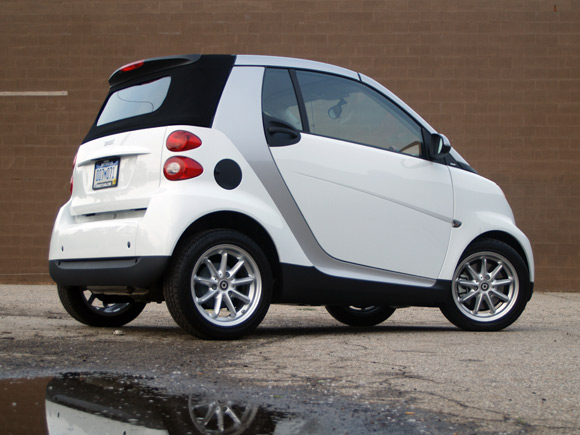
Still, the ForTwo has a full compliment of airbags and other active and passive safety features, and the NHTSA gave the ForTwo a four-star crash rating for the driver (three stars for the passenger), so it's hardly a death trap. Instead, it's a fun but flawed little ride, neither at home in the city nor on the highway.
It's easy (and maybe justifiable) to criticize the ForTwo. "It's only half a car," one friend joked, and the love-it-or-hate-it styling is the most obvious hurdle to ownership. But after driving the Smart ForTwo Passion cabrio in a variety of environments, the fog of novelty wears off and the truth is revealed: there's no ideal environment for this ultracompact runabout.
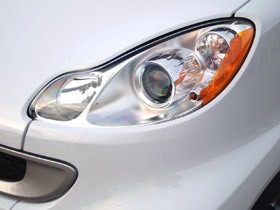
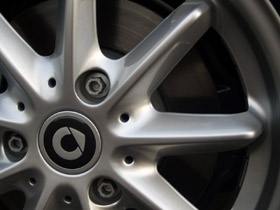
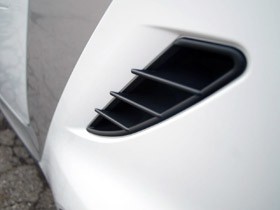

If you're a commuter in an urban area and only plan to use the ForTwo as a means to get to and from work, you could make a case for the Smart. The good news is that the ForTwo could serve as a road-trip machine in a pinch. And yes, its eight cu.-ft. of cargo space (12 if you fill it to the roof) is enough for a light grocery run – just don't put your ice cream at the bottom of the bags because the ForTwo's perfectly adequate 70-hp, 1.0-liter turbocharged three-cylinder sits between the rear wheels and quickly heats up the rear cargo area for insta-milkshakes. But as an everyday vehicle, the Smart ForTwo fails to stack-up. And it begins with the transmission.
Although the ForTwo's automated manual gearbox has been "improved" from the 2008 model, it's still an unforgivable mess. There are two shifting options: a full automatic mode and a manual option that allows the driver to use either the steering wheel-mounted paddles or the floor-mounted shifter to change gears sans clutch. In automatic mode, the changes are inexcusably jerky, especially between first and second. Using the paddles allows for a slightly smoother shift by manipulating the throttle, but the manual shifting doesn't feel particularly useful as it only allows you to choose when the hiccups happen and does little to alleviate the (neck) pain.
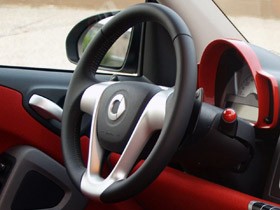
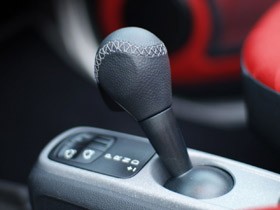
As you'd expect, this puts a serious chink in the ForTwo's urban armor. While it's size is great for parking and the little car zips in and out of traffic with ease, in city driving, where the transmission is most active, the constant shifting makes low- to mid-speed maneuvers a torturous affair. While it might be possible to learn to live with the lurches, our week with the ForTwo wasn't enough – and we doubt any amount of time could dull the discomfort.
After answering the most common queries (What is it? Who makes it? Is it electric?), the next inevitable and justifiable question is about fuel economy. Again, the ForTwo has a surprisingly hard time justifying itself here. We averaged 35.7 mpg during our week with the car, just under the EPA's official 36 mpg combined rating. Initially, we left shifting duties to the ForTwo's computer-controlled tranny, resulting in a 32.7 mpg average. When we decided to stick the Smart Cab into the manual mode and use the paddle shifters, we managed 38.8 mpg. Maybe they're not so useless after all?
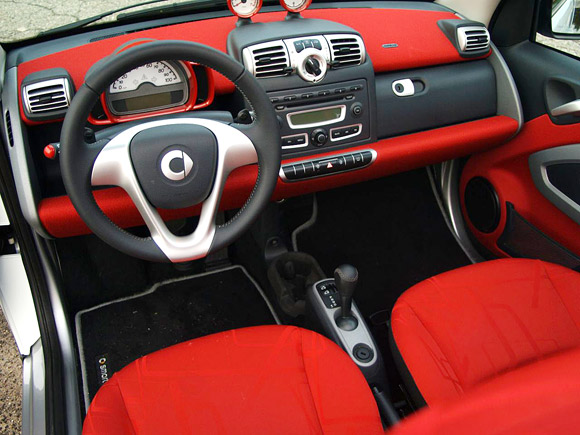
From the driver's seat, the ForTwo does its best imitation of a sleek, modern desk. The top of the dash is expansive, and the designers completely nailed a chic, Euro-feel with the colors and layout. Virtually unchanged since the 2008 model, the gauges are stylish yet easy to read. The mid-mounted tachometer is a necessity in manual mode, since it's difficult to hear the engine crying for a change if the radio is on. The tachometer works better than the built-in indicator that flashes an "up" or "down" arrow below the speedometer when it's time to shift, as the LCD indicator is the same color and shape as the gear display and blends in. A separate colored icon, similar to what's found in modern VWs, would have been a better choice.
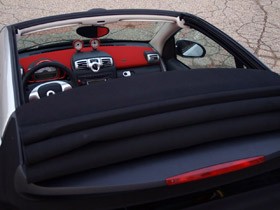
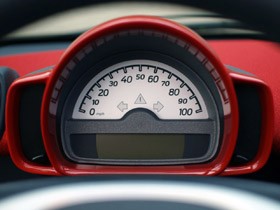
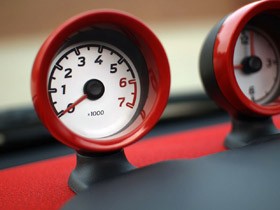
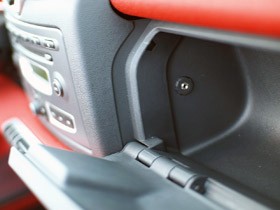
Other usability issues? While the visors provide an acceptable amount of shading through the windshield, they're practically useless when the glare comes in at anything beyond 11 and one o'clock. Rear visibility provided by the inside mirror isn't great, but works – except when the top is down. Two buttons by the shifter allow you to automatically fit or retract the Passion Cabriolet's top at any speed, eliminating any feeling of separation between the occupant and the environment. But when your enjoying the open-air experience, it's best to perform multiple checks when backing up or doing a lane change as visibility becomes a finite resource. Thankfully, the ForTwo's squat footprint allows you to slide into spaces with a minimum of butt-puckering.
It's also easy to enjoy the passion's standard audio system, which comes with a six-disc changer and an auxiliary jack in hidden in the glove box. The location of the input jack is great when you're on the road as the iPod remains safely tucked away, but it's not so hot when stopping and starting. More than once, we left the player running because we forgot it was in the lockable glove box.
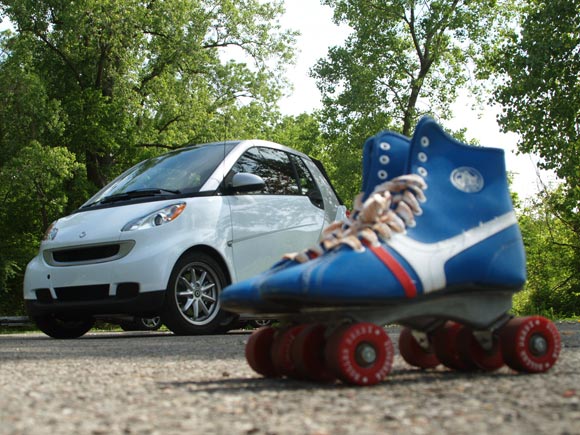
The sticker of our tester came in at $16,990, but the line ranges from $11,990 for the Pure Coupe to $20,990 for the BRABUS Cabriolet. Low sales in 2009 have prompted Smart USA to offer its first ever incentive for buyers, but even with a lower sticker, the ForTwo is difficult for us to recommend. Although some of its drawbacks disappear when you're enjoying the "ForTwo Experience," its abysmal transmission, general lack of utility and fuel economy that comes off as unimpressive for its size doesn't make a compelling case for the ForTwo outside of casual city drivers who value fashion over function, and like to meet new people.
Photos Copyright ©2009 Sebastian Blanco / Weblogs, Inc.
| 2009 Smart ForTwo |
|
|
|
|
| |
|
|
|
|
| Performance | |
|
Brakes/Tires/Wheels | |
| Engine | 1.0-liter inline three |
|
Front Brakes | 11-inch ventilated discs (ABS) |
| Configuration/Valvetrain | SOHC, 4 valves per cylinder | |
Rear Brakes | 8-inch drums |
| Max Horsepower @ RPM | 70 hp @ 5,800 RPM | |
Wheels (front) | 15x4.5-inches |
| Max Torque @ RPM | 68 lb-ft @ 4,500 RPM | |
Wheels (rear) | 15x5.5-inches |
| Drive Type | Rear-wheel drive | |
Tires (front) | 155/60 R15 |
| Transmission | Five-speed automated manual | |
Tires (rear) | 175/55 R15 |
| Fuel Injection | EFI | |
|
|
| Compression Ratio | 11.4:1 | |
Exterior Dimensions | |
| Recommended Fuel | 91 octane | |
Length | 106.1 inches |
| Fuel Capacity | 8.7 gallons (incl. 1.3 gal reserve) |
|
Width | 61.4 inches |
| EPA Fuel Economy (city/hwy) | 33/41 | |
Height | 60.7 inches |
| 0-60 mph time (MFR est.) | 12.8 seconds | |
Wheelbase | 73.5 inches |
| Top Speed | 90 mph | |
Curb Weight | 1,808 pounds |
| |
|
|
|
|
| Suspension/Steering | |
|
Interior Dimensions | |
| Front | MacPherson, with anti-roll bar | |
Maximum Seating | 2 |
| Rear | DeDion axle | |
Luggage Capacity | 7.8 cu-ft |
| Steering | Rack-and-pinion | |
Head Room (Front/Rear) | 39.7 / 0 inches |
| Turns Lock-to-Lock | 3.4 | |
Shoulder Room (Front/Rear) | 48 / 0 inches |
| Turning Circle (feet) | 28.7 | |
Leg Room (Front/Rear) | 41.2 / 0 inches |
| |
|
|
|
|
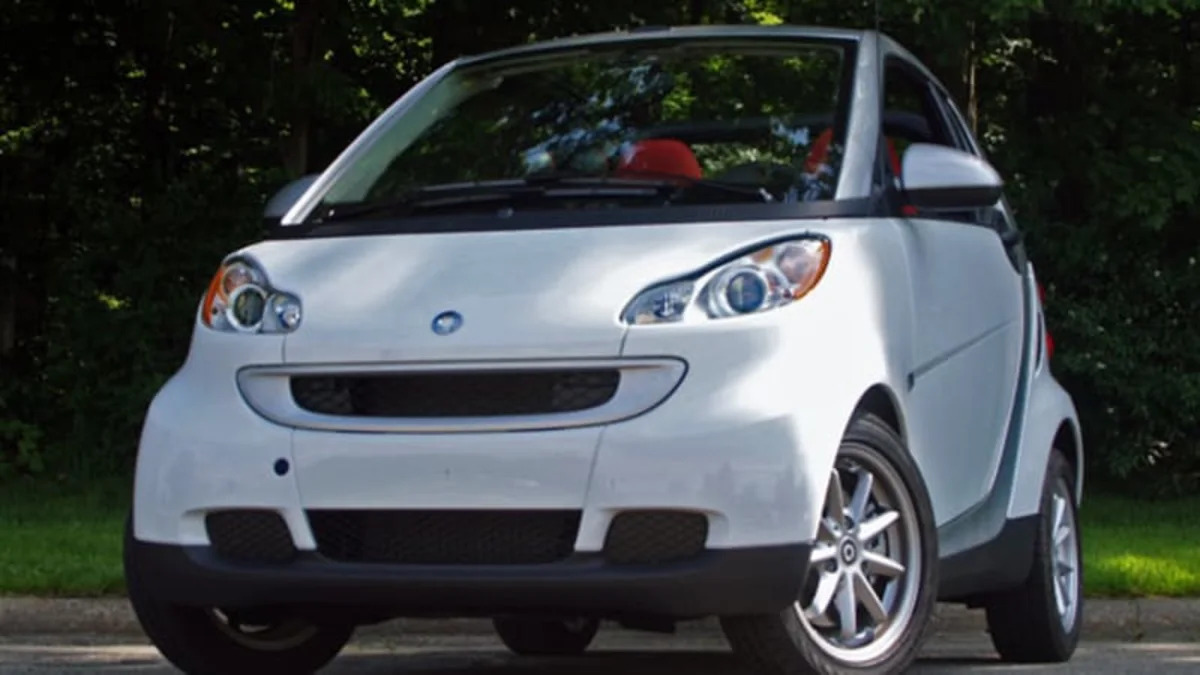

Sign in to post
Please sign in to leave a comment.
Continue